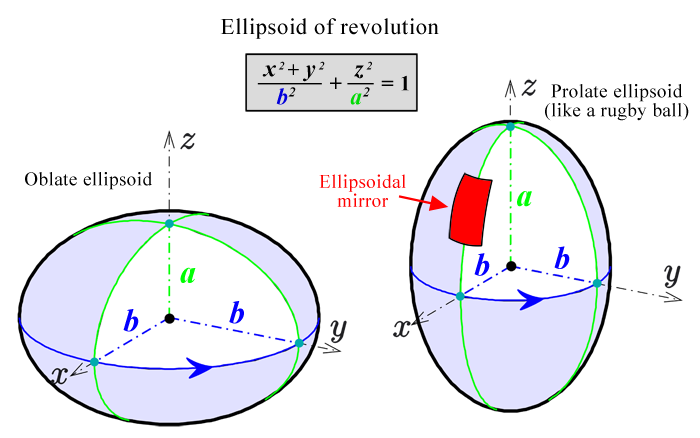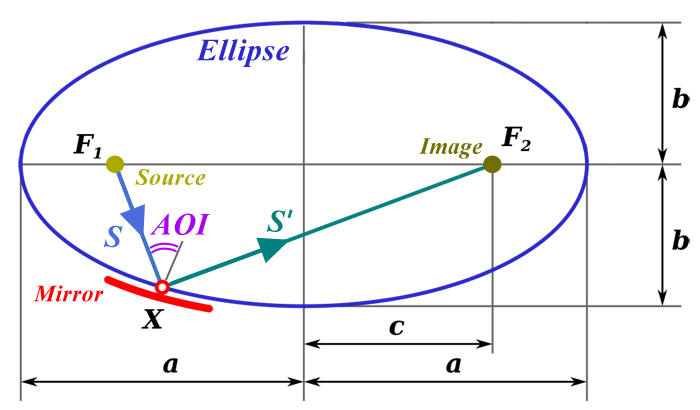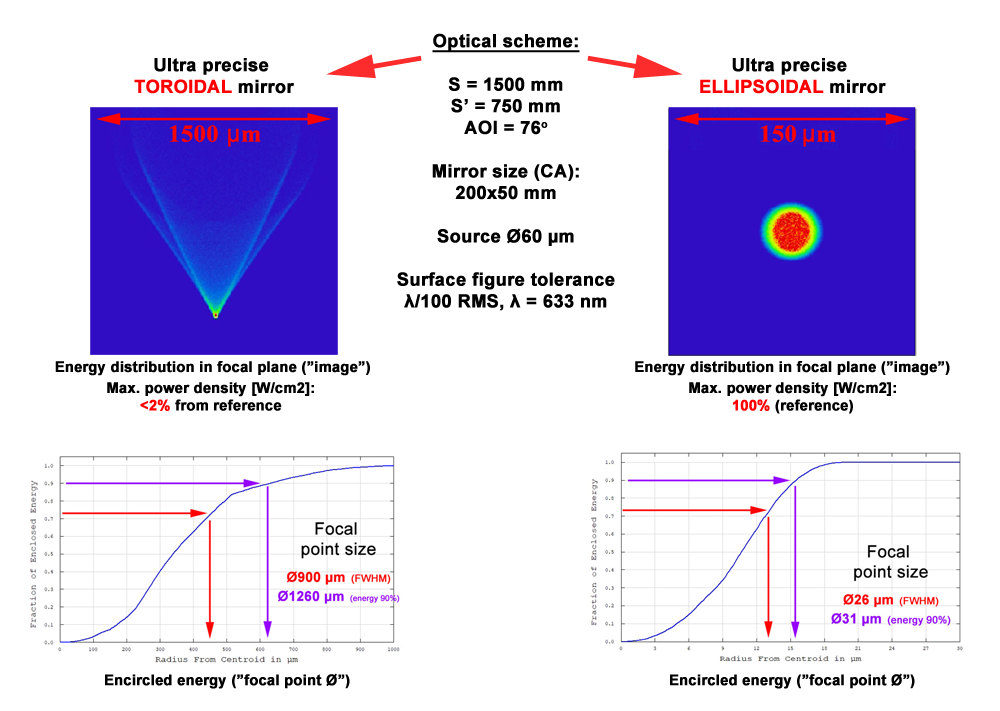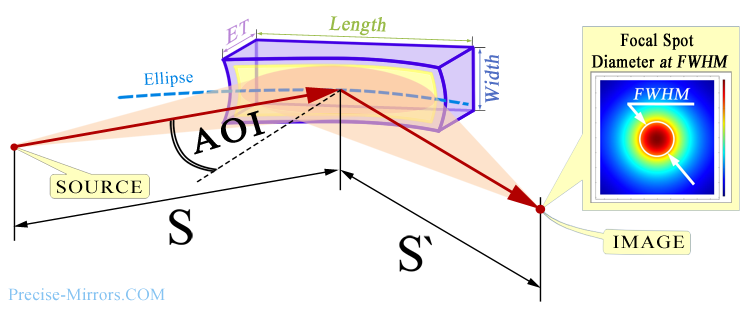
Other mirrors types for "grazing schemes"- look
here, for a example
toroidal mirrors
or
off axis parabolic mirrors.
An ellipsoidal mirror is part of the surface of an ellipsoid.

An ellipsoid has the property that a ray emerging from one of its focuses will always fall into its second focus (see figure below). Accordingly, an ellipsoidal mirror is used to focus radiation diverging from a point source. Moreover, ellipsoidal mirrors have no spherical distortion at all. Therefore, for ellipsoidal mirrors the values of S, S' and AOI can be any (whereas for toroidal mirrors, the more S differs from S' and the smaller the AOI value, the greater the spherical aberrations will be).

Ellipsoidal mirrors are often used to reflect radiation with short wavelengths (less than 50-100 nm and up to several nm). In order to achieve a noticeable reflectance of the mirror in this spectral range, it is necessary to use very large angles of incidence (usually 70-85 degrees and up to 89.5 degrees, hence the term "grazing angle", which is equal to 90 degrees minus the angle of incidence). Spherical surfaces at such large angles of incidence will give very large aberrations, toroidal mirrors often also have large spherical aberrations, so an ellipsoidal form of reflective surface can be used because this type of reflective surface completely free of this drawback.
| Mirror minimal and maximal sizes: | from 40 mm to 1200 mm | |
| Mirror substrate material: | Astrositall, by request: Zerodur, UV FS, Si and other. | |
| Coatings: | Metallic (Ag, Au, Al) and special EUV|XUV. | |
| Manufacture accuracy (RMS, λ=633 nm) | Base | Maximal |
| surface shapes, spherical mirrors | up to λ/140 | up to λ/400 |
| surface shapes, aspherical mirrors | up to λ/100 | up to λ/300 |
| Radiuses manufacture accuracy | up to ±0.05% | up to ±0.001% |
| Surface microroughness, RMS | 0.3 nm | 0.15 нм |
| Cosmetic quality (per square inch) | 40/20 scratch/dig | 10/5 scratch/dig |
In fact, the only disadvantage of ellipsoidal mirrors is the high complexity of their production and, as a consequence, their high cost and longer production times (especially for mirrors with large asphericity). Also for the production of ellipsoidal mirrors with good accuracy of the shape of the reflective surface, manufacture needs both special equipment for their production, and special rare and expensive equipment for measuring the accuracy of the manufactured mirror (ordinary, even the most expensive, for example industrial Zygo - it will not be enough to carry out measurements in such a non-axisymmetric optical design). Therefore, find someone who can make an ellipsoidal mirror with an accuracy better than approximately RMS λ/10 and micro-roughness of about RMS 0.5 nm, very difficult. At the same time, simple arithmetic shows that when the mirror operates with wavelengths < 100 nm, surface shape accuracy should be closer to RMS λ/50 ... λ/100 (where λ = standard 633 nm).
The main advantage of ellipsoidal mirrors is that they have no aberrations at all (at least from a practical point of view). Those, with sufficiently good precision in manufacturing the shape of the reflective surface, it does not matter at all what the distance to the source S and image S' is, no matter what the angle of incidence AOI and what dimensions of the mirror - always the focused spot (it is also the image of the source) will be equally minimal, up to diffraction limitations (whereas for toroidal mirrors the size of the minimum focused spot strongly depends on the optical design and can give either a diffraction-limited focal spot or, for example, a “classical butterfly” of millimeter size, see example below).

Important! Distortion will be present even with very high precision manufacturing of the toroidal shape of the reflective surface. It is important to understand that the use of optical schemes with the so-called “2f geometry” (this is when S=S') does not provide a guaranteed solution to the problem of spherical aberrations, You can see it in the example here . There is also a widespread misconception that using two identical conjugated toroidal mirrors eliminates large spherical distortions (in theory this is true - the second toroid must compensate for the distortions introduced by the first toroid). But in real practice everything is much more complicated, for a example, see third page of our standard quotation , where the stability of a real scheme with two identical conjugate toroidal mirrors is simulated).
Thus, the main conclusion is to use an ellipsoidal mirror - this is actually the only a guaranteed way to obtain the best focused spot that can theoretically be obtained in Your optical scheme.
Typically, it is very important for the customer how small a spot in the image plane can be formed by the mirror
(see figure below).

The size of the spot in the image plane depends on many different factors, but from real practice for ellipsoidal mirrors this is only the accuracy of manufacturing the shape of the mirror surface and sometimes diffraction limitations at the operating wavelength. Also, the accuracy of the adjustment is often extremely important, since sometimes, for example, the error in the position of the mirror is only a few microns can increase the diameter of the focused spot several times.
The general principle is that the closer the size of focused spot
to the diffraction limit, the more expensive such a mirror is.
It depends on Your task and the funds allocated for the purchase. The most competent and correct way would be to fill out our special "request form" (here it is help in filling out (pdf) ). It is also advisable to attach to the request form a description of Your optical design (at least in words), in which the mirror will operate and all this send to our email quote@precise-mirrors.ru. Next, our specialists will select several suitable options for You (see example of a typical quote for single mirror or for two conjugated mirrors ).
You can also send a detailed exact specification of the mirror You need with drawings, a description of the type of surface shape, calculated radii, with all tolerances, etc. But even in this case, it is better to add at least minimal information on the angle of incidence, the size of the source and the desired image size. From our extensive practice, in such cases it is often possible to at least optimize the radius, with which the result will be slightly better and the customer does not incur any additional costs.
You also don’t have to fill out "request form" , and do not send a detailed exact specification of the mirror you need, but instead send a description of Your task (mirror) in any form to the same email address quote@precise-mirrors.ru. But in this case, such a request may take much longer to process.